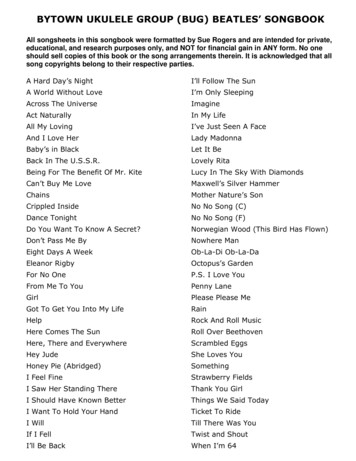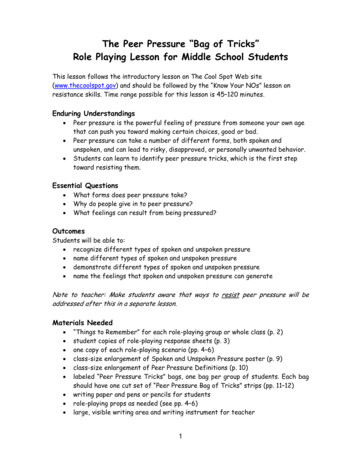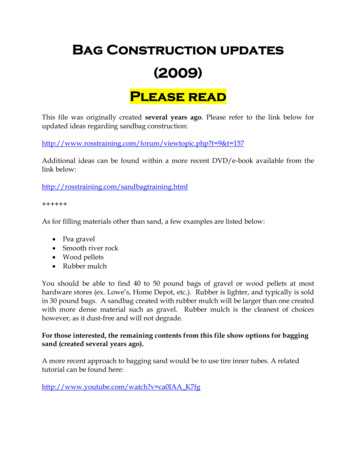![[Type Here] BUG OUT BAG CHECKLIST - Skilled Survival](/img/14/bug-out-bug-out-bag-checklist-v3.jpg)
Transcription
[Type here]BUG OUT BAGCHECKLISTCopyright 2016 SkilledSurvival.com – All Rights Reserved - Disclaimer
This is Skilled Survival's Ultimate 104 Item Bug Out BagChecklist. A free bug out bag checklist that not only tellsyou what to add to your pack but why.A Quality Bug Out BagBefore you begin filling your bug out bag with all yoursurvival gear and supplies, you need a high-quality bugout bag.Starting your bug out bag build with a crappy pack is aterrible idea so make certain you get one with the followingqualities: Made with thick, tough fabrics Includes a MOLLE system Has padded hip support straps Water resistant or includes a shell High quality no jamb zippers Includes a lot of pockets andcompartments1 – Bug Out BagThe 511 Tactical is a badass bug outbag and an ideal pack for anyoneserious about putting together a legitbug out bag.Copyright 2016 SkilledSurvival.com – All Rights Reserved - Disclaimer
Once you've got your bug out bag, it's time start buildingyour bag with survival gear.Note: This bug out bag checklist is intended to provide youall the possible items you may want to add to your bag.However, if you added everything suggested from this bugout bag checklist into your bag it’s going to get way tooheavy.You should pick and choose the gear and supplies thatmake the most sense to meet your needs.Water and HydrationFor SHTF, you're going to want at least three separateways to your water sources. Drinking contaminated watercan make you severely sick and can even kill you.Why not just carry all the water you'll need? Not an option,water is extremely heavy so you'll have to find it along theway.That's why you'll need key purification tools to filter andtreat the water you find.Copyright 2016 SkilledSurvival.com – All Rights Reserved - Disclaimer
2 – Stainless Steel Water BottleYour choice of water bottle matters. It'simportant to get a water bottle made out ofstainless steel and not plastic. You can'tboil water in a plastic bottle, and boiling isthe simplest way purify the water you findto ensure its safe to consume.So fill your stainless steel bottle today with safe, cleanwater and stash it in your bug out bag. That way you canstart your bug out with a full bottle of clean water and thenrefill and boil/filter/purify as needed along your route.3 – Water Purification TabletsAn alternative method to purify water from rivers andstreams when boiling is too time-consuming is to carrysome water purification tablets.These tablets treat water faster than boiling, and theyallow you to purify on the go and keep moving. Plus theyare extremely lightweight so that you won't pay much ofa weight penalty.4 – Portable Water FilterA good water filter will remove all theparticulates from your water such asdirt or soot, but a great one will alsoCopyright 2016 SkilledSurvival.com – All Rights Reserved - Disclaimer
remove most harmful bacteria as well. So you should packa small portable water filter to clean your water and purifyit too.The LifeStraw is my water filter of choice since it's bothsmall and portable. It'll save you a lot of pack weight andspace compared to larger units.Get a couple of them; one for each family member.5 – Expedition Jerry Can Filtration SystemThis is not a small filter and it won't fit inside your bug outbag. However, with your MOLLE system you can hang iton the outside of your bag.The LifeSaver Expedition Jerry Can is ideal for a familybug out since the system can supply enough clean waterfor a family of 4 for nearly a year.Clip it to the outside of your bug out bag empty and use itonce your family arrives at your final bug-out location.Food Supply ItemsYou need to pack some calories. A few essential foodsources stashed in your bug out bag to keep you healthyand maintain your stamina. For can get heavy so you'llwant to focus on light, easy to prepare foods.Copyright 2016 SkilledSurvival.com – All Rights Reserved - Disclaimer
But you should also try to take advantage of what the landcan provide. So make sure to pack a few survival tools tohelp hunt or gather additional foods along your bug outroute.6 – Calorie Dense Food BarsHonestly, any calorie dense energy bars will do the trick.Just read the label and look for ones that provide the mostcalories per bar.These ER Emergency Food Ration Bars pack 2400calories per bar, which is exactly what you need.These food bars will provide your primary energy needson your journey since they are easy to consume on the go,and you can pack quite a lot of them without adding muchweight.Plus they have a decently long shelf life (5 years).7 - Freeze Dried MealsFreeze dried foods are a hot meal in a pouch. Makingthem another a light food source you can add to your bugout bag. They take a few minutes to prepare so wait untilyou find a safe spot to rest. Just add the pouch contents toboiling water, stir, and eat up.I personally use and recommend Valley Food Storage’sfreeze dried foods.Copyright 2016 SkilledSurvival.com – All Rights Reserved - Disclaimer
8 - Military Meals (MRE - Meals, Ready to Eat)If MRE's are good enough for soldiers, then they are goodenough for me.There is some debate about MRE's for survival. Here'san excellent discussion on this hotly debated topic if youwant to dig deeper.9 – Eating UtensilsUnless you prefer eating with dirtyhands, you'll want something smalland light to move your food frompouch to mouth.Get this awesome titanium Spork; it's both a spoon and afork. And a 2 for 1 is always a good deal in survival. Plus,it's made from light but strong titanium, so it weighs only20 grams.Now as a side note, you won't need a small knife becauseyou can use your survival knife instead (a separate listitem later).10 – Small Collapsible BowlYou'll want an easy way to keep yourprepared food contained for serving andCopyright 2016 SkilledSurvival.com – All Rights Reserved - Disclaimer
eating. In our homes we use plates, but they are heavyand take up a lot of space. So instead get one of thesecollapsible bowls, they are ingenious, and they work great.11 - Braided Fishing LineFish are an excellent source of protein if you can snagthem. Fishing while bugging out is not always possible,however you definitely won't catch any without somefishing line.Get braided fishing line since it’s highly durable and cantake more abuse than the regular fishing line. You won'tneed much so you can get the small spool, but you'll haveto decide what lbs. test line will work best for your needs.The bottom line is that having some fishing line is a greatsurvival tool to have in your bag. It's light, durable and canhelp you catch fish or help with other survival needs.#12 - Fishing Pole (small, collapsing, orpocket)Recently some ingenious ultra-small fishing poles havebeen invented. Small Fishing Pole Collapsing Fishing Pole Pocket Sized Fishing PoleCopyright 2016 SkilledSurvival.com – All Rights Reserved - Disclaimer
Any of these options will work great, and they break downto easily fit into your bug out bag.Make certain to take them with you on your next fishingtrip so you can get experience using it.13 – Yo-Yo Fishing ReelsI recently stumbled on these ingenious little devices.You can set several of these out, leave them, and thencome back to check on them later. So you won't have towaste precious time actively fishing.You'll have better things to do mid bug out than castingand reeling for hours with no guarantee of success.Better to set your fishing yo-yo's up and come back later. Ifyou catch a fish or 2, you're ahead of the game, but if youdon't, you didn't waste a ton of time.14 – Hook, Swivel, Sinker SetWe've already covered fishing line and poles but withouthooks, swivels and sinkers you're going to have a hardtime catching anything.Keep it light, since you only need a small number ofeach. This little case includes 75 pieces which you shouldremove about 2/3 of them before packing to save weight.Copyright 2016 SkilledSurvival.com – All Rights Reserved - Disclaimer
15 – Portable Light Weight StoveThis piece of survival gear is a personalchoice of whether to include it in your bugout bag or not. You CAN definitelysurvive without it and save the weight.Your call.With that said, you can use it to boil water faster thanhaving to build a fire. It also makes your freeze driedpouch food preparation both easier and faster.Another consideration is stealth. A fire can give away yourposition to others, especially at night. However, with thissmall stove, you'll be able to cook your food without nearlyas much exposure.16 – Stove FuelIf you decide to pack a stove, then you'll need to purchasea couple of fuel containers to go with it.Grab a couple and try to use them as sparingly aspossible. Eventually, they will run out, but if they get youto your bug out location before they do, then you win.17 – Snare WiresSetting up snares overnight might bag you a couple ofsquirrels or rabbits on the go. Snare wires are a lighterCopyright 2016 SkilledSurvival.com – All Rights Reserved - Disclaimer
option than traps, so they are the right choice for your bugout bag.Be forewarned, though, they won't be of much use unlessyou know what you're doing.However, if you do learn the art of snaring, then they canbe incredibly useful when bugging out.18 – Survival SlingshotYou can learn how to use a slingshot quickly with somededicated practice.Like most survival skills, it will take some practice, but thislightweight hunting slingshot is a decent option forsourcing some protein.19 – Daily Multivitamin SupplementStash some daily vitamins to help maintain your overallheath.Your diet will become severely limited in the wilderness,so taking a daily vitamin supplement will help keep yourmind and body strong.Copyright 2016 SkilledSurvival.com – All Rights Reserved - Disclaimer
Clothing and Warmth ItemsRule #1 - Only carry as much clothing as you need forsurvival.Rule #2 - Don't forget rule number 1.Spare clothes will take too much precious pack space andweight more than you think. So try to limited additionalclothes to just a couple of the main undergarments.Plan on wearing the same set of durable clothes every dayand then just change out your undergarments to maintainreasonable hygiene.Remember, if you're bugging out, it's because of a survivalevent forced you to leave, so multiple changes of clothesis not a luxury you can afford.20 – Fresh SocksWhile I just suggested you compromise on your main clothitems (shirts and pants), I don't recommend the same foryour socks. Your feet are just too important during a bugCopyright 2016 SkilledSurvival.com – All Rights Reserved - Disclaimer
out. You can't afford to get trench foot or severe blisters.So rotate a fresh pair of socks daily.The socks I've trusted with my feet on the trail for yearsare these smart wools. They are thick, warm andcomfortable when you're walking long distances.Pack one pair and wear one pair. Wash, dry and rotatedaily.21 – Quick Drying UndergarmentsPack the quick-dry variety of undergarments so you canwash and then tie them to the outside of your pack to dry.They are designed to dry quickly, so you only need onespare set of underwear and undershirt in your pack.Rotate daily.22 - Sewing KitToo tough for a sewing kit? Get over it!Since you're only taking one main set of clothes (the setyou'll wear every day), you'll need a small light travelingsewing kit. A sewing kit allows you to mend your clothesshould they rip or tear on the trail.23 – Safety PinsCopyright 2016 SkilledSurvival.com – All Rights Reserved - Disclaimer
Safety pins are designed specifically to pin clothestogether. So in a pinch, having a few stashed to hold a riptogether until you can stitch a more permanent patchmakes sense.These safety pins are heavy duty so they will work betterin tough environments than regular ones.24 – Survival GlovesWhen it gets cold out, you'll needa set of warm gloves. I pack a set ofMechanix gloves because they’redesigned for people who work withtheir hands.With these gloves on your hands, you'll have enoughdexterity to use your survival knife or a firearm withouttaking them off.25 – Stocking CapIn cold weather, plan to retain as much body heat aspossible.And while it's a myth that we lose the majority of our bodyheat through our heads, it's still wise to keep your domecovered in the cold.Pack a camouflage stocking cap to avoid detection in thewild or a grey one if you must travel through a city.Copyright 2016 SkilledSurvival.com – All Rights Reserved - Disclaimer
26 – Body WarmersKeep a few body warming packets stashed in your bug outbag just in case. Then save them for serious emergenciesonly, like just before the threat of frostbite.You can't afford to lose your fingers or toes to frostbite insurvival. That situation would be game over.27 – Rain Poncho with HoodNothing will drain heat from your body (and from yoursoul) than hiking in drenched clothes.It's a miserable experience, and it's very dangerous in thecold.This Princeton study shows that, "Generally conductiveheat loss accounts for only about 2% of overall loss.However, with wet clothes the loss is increased 5x."So pack a poncho. Ponchos are thin, light and take uplimited space.Get one with a hood to keep the rain off your head.Also, get one that's durable and won't tear easily in therugged wilderness. It may cost a few dollars more, but it'sworth it. Because if you're cold and wet forlong, hypothermia is coming.Copyright 2016 SkilledSurvival.com – All Rights Reserved - Disclaimer
Shelter and Bedding ItemsYour choice of bug out survival shelter comes down to apersonal preference. Personally, I don't pack a fullfledged tent. The tent poles and anchors are too heavy.Instead, I use my survival skills and knowledge to make abasic survival shelter.28 – Tarp ShelterWith a simple tarp shelter and key survival skills, you cancreate a space that is as good as a traditional tent.It will 1) keep the rain off you, 2) break the wind and 3)give you a "safe" space to sleep at night. So why carry allthe extra weight of tent poles?29 – Survival HammockA hammock is another survival solution for a singlesleeper.Copyright 2016 SkilledSurvival.com – All Rights Reserved - Disclaimer
Combine a good sleeping bag with a hammock and you'llbe warm, off the ground, and dry. All you need is a coupleof trees and some paracord to tie off.You might consider getting one with a mosquito net builtin.30 – Sleeping Bag and Bivy CoverWe all know what sleeping bags are, but the term "bivysack" may be new to you. Bivy sacks are a waterproofshell that fits over your sleeping bag.When bugging out, staying warm and dry is critical tosuccess. This sleeping bag will keep you warm,and this camo bivy cover will keep you dry (and hidden).31 - Sleeping PadWhile a sleeping pad provides some comfort, it's primarysurvival function is to insulation you from the cold hardground.You need something between you and the groundbecause laying directly on the ground sucks the warmthand energy out of your body.You can forgo a pad and get insulation by building a layerwith wilderness debris (i.e. leaves, pine straw, etc.) butonly if you know what you're doing.Copyright 2016 SkilledSurvival.com – All Rights Reserved - Disclaimer
Avoid air-filled pads (like a mini air mattress) since theyare useless if punctured. Instead, get this light, durableoption made out of a rubber-like material.The best way to add a sleeping pad to your bug out packis to roll it up and attach it to the outside because therewon't be enough room on the inside of your bug out bag.32 - Zip TiesIf you stop to think about it, zip ties are an amazinginvention. They are tough as hell, light, and allow you tocreate tight connections. Many police departments usa thick set of zip ties instead of handcuffs.They have a large variety of additional survival uses too.As far as shelters go, use them to tie branches together tocreate simple survival shelters.33 – Paracord GrenadeParacord has so many survivaluses I could have added “paracord"to nearly every bug out checklistcategory.In the case of shelters, it can be used to tie branchestogether or to attach your tarp to trees. It can also anchoryour hammock to trees.Copyright 2016 SkilledSurvival.com – All Rights Reserved - Disclaimer
Snag up one of Skilled Survival's free paracordgrenades and clip it to the outside of your bug out bag.Fire Starting Tools and GearYou need 3 independent ways to start a fire.Fire is your life blood in a survival emergency. You need itto purify water, cook food, for nighttime warmth, safety,and it's a huge morale booster.Once you have your 3 critical fire starting tools, practice soyou know how to use them.And if you really want up your survival game, learn how tostart a fire with sticks. It takes serious survival skills tostart a fire with sticks in high wind or wet conditions.34 - Waterproof Survival MatchesWaterproof matches are the real deal.Regular matches are not good enough. Ifregular matches get wet, forget abouthaving a fire.35 – FireSteel Fire StarterFireStriker’s work great if you know what you're doing. Ithelps to have a very fine, dry tinder bundle to get thesparks to ignite.Copyright 2016 SkilledSurvival.com – All Rights Reserved - Disclaimer
This fire striker is fantastic and is designed with 3,000strikes, but practice with it before relying on it.36 – Windproof – Waterproof Electrical LighterA lighter is a lighter right? Not really.Can your cheap BIC lighter work after dropping it in ariver? Nope. Will a cheap BIC lighter's flame stay lite in 80MPH winds? Nope.So I recommend spending a couple extra dollars on a newbadass fire starting technology: Tesla's Rechargeable CoilLighter.This lighter doesn't use fuel, so you'll never run out. It useselectricity to create an electric arc which is both windproofand waterproof. It charges via a USB port so you'll needa solar charger or a hand crank radio to recharge (bothitems discussed later in this bug out bag checklist).37 - TinderAs an experienced survivalist, you can normally findnatural tinder in the wilderness. However, it's always smartto prepare for the worst, so pre-pack some tinder tabs aswell.Cotton balls work well, or you can buy these Quick FireTabs that are specially made for easy ignition. They hold aCopyright 2016 SkilledSurvival.com – All Rights Reserved - Disclaimer
flame longer giving you time to catch the tinder flame toyour small kindling.38 - VaselineAdd a dab of vaseline to tinder and it will help it ignitequickly and easily.39 – Small Magnifying GlassWith the sun you can use magnificationto focus light energy. This focusedenergy can be harnessed to make a fire.This device will work if you run out ofbutane or matches.Plus, this Gerber Tinderbox helps make fine tinder fromsticks and includes the magnifying glass built in.40 - Small Waterproof Storage ContainerYou should stash all of your fire starting tools into an O-ringsealed waterproof container.This container will keep your fire starting tools dry in adownpour or if you fall in a river with your pack.Copyright 2016 SkilledSurvival.com – All Rights Reserved - Disclaimer
First Aid and Medical SuppliesWhen in the wilderness, exposed to the elements,there's an increased chance of illness or injury.So add the essential first aid supplies to be able to treatthese issues. Remember, a minor cut can kill viainfection if not properly treated.41 - Personal MedicationsIf you have prescribed medications, then stock up and addthem to your bug out bag.42 - Wound Gauze RollGauze is the ideal dressing for bad cuts or severeburns. It's light and takes up very little pack space.Copyright 2016 SkilledSurvival.com – All Rights Reserved - Disclaimer
43 - Surgical TapeThis stuff is made to keep gauze, pads, and bandages inplace even when you're on the move.44 - Band Aids / Mole Skin PadsBand-Aids are the best solution for small cuts andlacerations. They help keep open wounds clean andprotected, which helps prevent an infection fromdeveloping.You should also add a few moleskin pads for blisters.Band-Aids won't stay in place on your feet while walking,but moleskin will.45 – Neosporin (or similar salve)Add this cream to any cut or laceration to help preventinfections.46 - Pain KillersFor minor aches and pains, these can help keep yougoing. For serious injuries, pain killers will take the edgeoff until you can get more help.47 - Blood Clotting SpongeCopyright 2016 SkilledSurvival.com – All Rights Reserved - Disclaimer
Nasty, deep wounds won't clot on their own. You have toapply intense pressure to the wound site for a long time toget the blood stop, congeal, and begin the healingprocess.These Quick Clot Sponges will help with this life or deatheffort.48 - Super GlueSuper glue can be used to seal up small cuts. Plus, itcomes in handy in numerous other survival uses.49 – VaselineI'm aware this is the second time Vaseline made this bugout bag checklist, but it works as both a fire starter and asan ointment. Apply this stuff to your chapped skin or lips toprevent painful cracking.50 – Survival AntibioticsWhen SHTF, access to lifesaving antibiotics to cureinfections will become severely limited (if available at all).So stock up on a few bird or fish antibiotics and throwthem in your bug out bag, just in case.51 - Sterile Alcohol Prep PadsCopyright 2016 SkilledSurvival.com – All Rights Reserved - Disclaimer
Clean all wounds early and often with these alcohol wipes.The alcohol will clean the wound, killing infection-causingbacteria.52 - Hydrogen PeroxideSame idea as the alcohol pads, use it to keep woundsclean and bacteria free.53 – Q-tips Cotton SwabsUse Q-tips to clean your ears. Allowing excess wax tobuild up in your ears can lead to infection.And, wax buildup will also muffle your hearing. And clearhearing is a major advantage in survival.They are also ideal for applying small amounts of medicalsalves and liquids.Lastly, you can tear off the cotton ends and use them astinder to start a fire.They are extremely light and useful, so feel free to pack acouple hundred of them. You can get 500 of them foraround 6.54 - Tweezers and Nail ClippersPack a sharp set of tweezers to get slivers out and a goodset of nail clippers to trim your nails.Copyright 2016 SkilledSurvival.com – All Rights Reserved - Disclaimer
55 - Insect RepellentMosquitos are a nuisance and can transmit diseases so ifthey are abundant in your region you'll want to pack arepellent spray with high amounts of DEET.56 - Sun ScreenYou should only pack a small bottle of this, so you'll needto ration it. Save it for the worst days and instead, keepyour skin covered up.Get one with an SPF30, like this one, to protect you forlonger periods of time. Higher SPF's are just a marketingploy.A hat, long sleeves and pants go a long way to preventingsunburn but keep sunscreen handy for the worst days.Personal Hygiene ItemsThis is survival we are talking about, so if you enjoy dailyhot showers get ready for an abrupt change.When on the run, you'll need basic sanitation, butthat's NOT going to include daily hot showers.57 - Moist TowelettesCopyright 2016 SkilledSurvival.com – All Rights Reserved - Disclaimer
Pack a bunch of these shower wipes. They are a good lightweight hygiene solution on the go. It's no shower but, hey,it's better than nothing.58 - Mini ToothbrushesPack several of these small, light toothbrushes becausethey won't take up much space. Oral hygiene is importantto prevent all sorts of tooth problems.Dental work will be rare after TEOTWAWKI so taking theextra effort to prevent tooth problems will pay off in thelong run.59 – Mini-Toothpaste TubesThe mini toothbrushes come with a dab of paste built in.But you're going to use them more than once. You needa small tube of toothpaste to add to your mini brusheswhen the built in stuff runs out.Ration it to the extreme. You don't know how long it will bebefore you can restock, but try to use a little each day.60 - Dental FlossLight, small and highly useful.Dental floss will keep your gums healthy. Maybeeven more important than brushing.Copyright 2016 SkilledSurvival.com – All Rights Reserved - Disclaimer
61 – Sportsman SoapWhile moist towelettes can replace your daily shower,you'll want some sportsman soap for the occasional riverbath.Again, ration this stuff to the extreme unless you pack a lotof it. But it will get heavy and take up space if you do.62 - TamponsEveryone should add a few of these to their packs sincethere are at least 13 excellent survival uses for tampons.63 – Hand SanitizerUse a small hand sanitizer to clean your hands beforeeating. Try to avoid ingesting bacteria from your handsafter tromping through wilderness all day.64 - BandanaThe bandana is another multi-category item due to itsextreme usefulness. For personal hygiene, use it to wipeand clean.You can also use it as a makeshift dust mask.Copyright 2016 SkilledSurvival.com – All Rights Reserved - Disclaimer
Core Survival ToolsThese are traditional survival tools that didn't fit into ourother but out bag checklist categories. However, they areessential to your bug out's success.65 – High Quality CompassIf you're into survival, then you should own a high-qualitycompass and know how to use it.Navigation is too critical. Getting lost is too dangerous.Know where you are and the best way to get to your finaldestination. Learn how to use a compass (and keep it withyou) and you'll never get lost again.GPS devices run on batteries, so you can't rely on them ina bug out situation.66 – Tough Compact Folding ShovelIf you've buried some survival caches along your bug outroute, then you'll want a compact shovel to dig them up.Copyright 2016 SkilledSurvival.com – All Rights Reserved - Disclaimer
It also allows you to improve your shelter area by clearingand leveling the ground.A tactical version allows you to complete even moresurvival tasks such as digging, chopping, sawing, pickaxe, trenching, opening, etc. This one does all that andmore.67 - Survival KnifeI can't stress how important it is to invest in a high-qualitysurvival knife.Spend some quality time researching good survivalknives. Find one that meets your needs best because agood survival knife has so many critical survival uses.Then once you've settled on "the one", make sure youlearn how to use it in the wild with lots of practice.68 - Survival Series Multi Tool PlyersA multi-tool is another key survival toolto pack. The biggest difference betweenwhat a multi-tool can do, but a survivalknife cannot, is the plyers.These survival plyers allow you toperform many functions that would beimpossible with a knife alone.Copyright 2016 SkilledSurvival.com – All Rights Reserved - Disclaimer
69 - Portable Solar ChargerIf you pack any items that require electricity or batteries tofunction (i.e. cell phone, walkie talkies, flashlights, GPSetc.) you'll need a way to charge these devices.This portable solar charger easily attaches to the outsideof your bug out bag so you can capture electricity while onthe move.It's one of my new favorite bug out devices since it allowsme to carry some basic electronics with me.70 – Survival HatchetSurvival hatchets are awesome. They are helpful toaccomplish tasks quickly that using your survival knifealone would take hours.A good survival hatchet makes batoning branches for firewood a breeze.It makes chopping down trees a whole lot faster too. Plus,these survival tasks are hard on your survival knife, but ahatchet handles with ease.If you add a survival hatchet to your bug-out bag, get oneof the lightest ones you can find.Here's the one I use camping, and I stash it in my bug outbag when not in use.Copyright 2016 SkilledSurvival.com – All Rights Reserved - Disclaimer
71 – Small Wire SawIf you forgo adding a survival hatchet to your bug out bag,you should at least add a wire chainsaw. This wire saw willcut down small trees efficiently to help build shelters.Illumination ToolsIllumination is necessary for survival. You'll need goodlight to work under the darkness of night. And if forced tomove in the middle of the night you'll need it to see whereyou're going.I can't imagine bugging out without illumination devices.Attempting to do so would put you at anextreme disadvantage.72 – Super Bright LED HeadlampTwo words: Hands Free.Copyright 2016 SkilledSurvival.com – All Rights Reserved - Disclaimer
I recommend getting one with both high beam, low beamsettings; as well as rechargeable batteries.And with the rechargeable batteries, you'll need a way torecharge them. That's where a solar charger comes inhandy (later item in this bug out bag checklist) to keepyour LED headlamp batteries charged up.73 – Super Bright LED Tactical FlashlightWhile a headlamp is important,you should also carry an LEDTactical Flashlight.You have more control with ahandheld LED flashlight andcan shine it in multiple directions without having to turnyour head. I prefer using a Tactical flashlight instead of aheadlamp if I'm not using my hands to accomplish a task.Skilled Survival's FireHawk LED Tactical Flashlight is aperfect flashlight to add to your bug out bag. Click here tosnag one today.74 - Glow SticksGlow sticks work great to light up an entire area and notjust a particular spot, which can be helpful in a campsite.Copyright 2016 SkilledSurvival.com – All Rights Reserved - Disclaimer
However, they can give away your position to potentialthreats so only use these if you know you're in a secludedarea.Here's 10 more survival uses for glow sticks.Communications ToolsYou need information tools. Gathering information andsharing information during a bug out situation is critical forsuccess.Whether it's a severe weather forecast or knowing thelocation of potential threats.The more you know, the more you can plan and adapt onthe go.If you're in a small bug out group, you'll want tocommunicate with each ot
18 – Survival Slingshot You can learn how to use a slingshot quickly with some dedicated practice. Like most survival skills, it will take some practice, but this lightweight hunting slingshot is a decent option for sourcing some protein. 19 – Daily Multivitamin Supplement Stash











